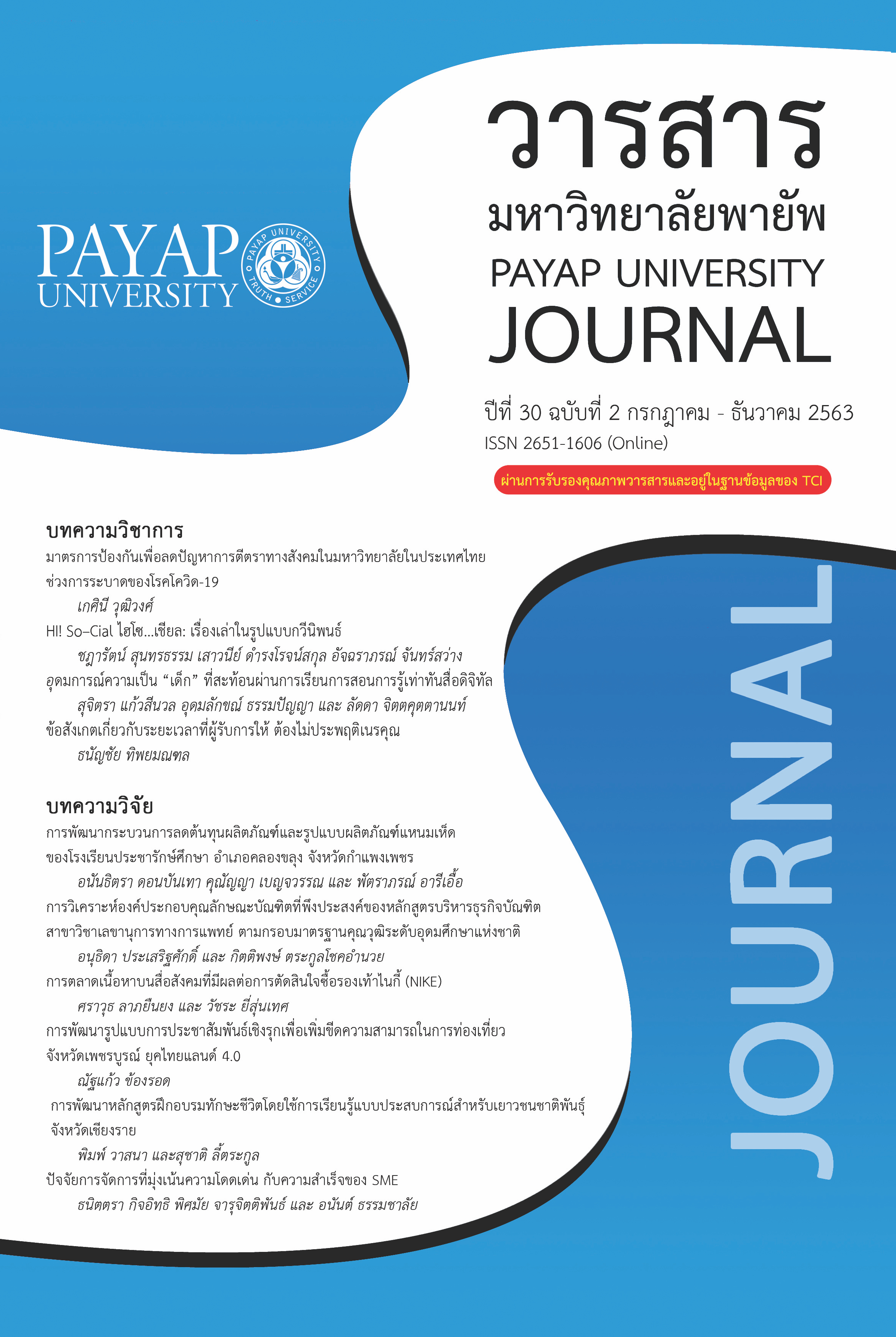ปัจจัยการจัดการที่มุ่งเน้นความโดดเด่นที่ส่งผลต่อความสำเร็จ ของธุรกิจขนาดเล็กและขนาดกลาง
Main Article Content
บทคัดย่อ
การวิจัยนี้ มีวัตถุประสงค์เพื่อศึกษาปัจจัยการจัดการที่มุ่งเน้นความโดดเด่นที่ส่งผลต่อความสำเร็จขององค์กรธุรกิจ ประชากรและกลุ่มตัวอย่าง คือ ผู้ประกอบการธุรกิจขนาดเล็กและขนาดกลาง (SMEs) ในเขตกรุงเทพมหานคร ขนาดกลุ่มตัวอย่างจากค่าตารางของเครจซี่และมอร์แกน จำนวน 385 คน เครื่องมือที่ใช้ คือ แบบสอบถาม การวิเคราะห์ข้อมูลโดยใช้สถิติพรรณนาและการวิเคราะห์การถดถอยพหุคูณ ผลการวิจัยพบว่า ส่วนใหญ่ เป็นเพศชาย อายุ 31-40 ปี มีระดับการศึกษาปริญญาตรี จำนวนบุคลากรในธุรกิจมีประมาณ 2-4 คน อายุกิจการ คือ 3-5 ปี ส่วนใหญ่อยู่ในกลุ่มธุรกิจการค้าและการบริการ ปัจจัยด้านการจัดการที่มุ่งเน้นความโดดเด่นด้านสัมพันธภาพ/เครือข่าย ส่งผลต่อความสำเร็จของ SMEs ทั้งในด้านความสำเร็จที่วัดมูลค่าเป็นเงินและความสำเร็จที่ไม่ได้วัดมูลค่าเป็นเงินอย่างมีนัยสำคัญทางสถิติที่ระดับ .05 ส่วนปัจจัยด้านการจัดการที่มุ่งเน้นความโดดเด่นด้านชื่อเสียงและนวัตกรรม ส่งผลตรงกันข้ามกับความสำเร็จทั้งในด้านความสำเร็จที่วัดมูลค่าเป็นเงินและความสำเร็จที่ไม่ได้วัดมูลค่าเป็นเงิน ความโดดเด่นในแต่ละธุรกิจอาจแตกต่างกันไปหรือมีมากกว่านี้ ผู้ประกอบการควรวิเคราะห์ว่า ความโดดเด่นที่มีอยู่ของธุรกิจตนคืออะไร เพื่อส่งเสริมให้เกิดความได้เปรียบในการแข่งขันอันนำไปสู่ความสำเร็จในระยะยาว
Article Details
เอกสารอ้างอิง
นงคราญ ไชยเมือง และจิรัฎฐ์ กาญจน์บุญเรือง. (2561). การจัดการเชิงกลยุทธ์ของวิสาหกิจเพื่อสังคมสู่ประเทศไทย 4.0. วารสารมหาวิทยาลัยพายัพ, 28(1). https://so05.tci-thaijo.org /index.php/pyu/article/view/141416/104794.
สำนักงานส่งเสริมวิสาหกิจขนาดกลางและขนาดย่อม. (2562). จำนวนผู้ประกอบการรวม ตามนิยามใหม่. สืบค้นเมื่อ 3 กันยายน 2563. https://app.powerbi.com/view?r=eyJrIjoiNzkzZTAyMjct NTdhOC00NzA0LTgwZTctMGM0NzM4ODc0NDY3IiwidCI6ImExZmZjMjhhLTEzZmMtNDhiMC05NGRmLWYyYWIyOGUwNWNhNSIsImMiOjEwfQ==.
สำนักงานส่งเสริมวิสาหกิจขนาดกลางและขนาดย่อม. (2563). บทสรุปผู้บริหาร รายงานสถานการณ์ MSME ปี 2563. สืบค้นเมื่อ 28 ตุลาคม 2563. https://sme.go.th/th/download.php?modulekey=215.
Andersen, N., Borsch, A., & Blohmke, J. (2017). Innovation in Small and Medium Enterprises: How startup management Practices Can Help in Solving Digitalization Challenges. Retrieved May 2019,
https://www2.deloitte.com/content/dam/Deloitte/de/Documents /Innovation/SME_komplett.pdf.
Barney, J. B., & Hesterly W. S. (2012). Strategic management and competitive advantage (4th ed.). Upper Saddle River, N.J.: Pearson/Prentice-Hall.
Chukwube, J. (2017). Networking is The Backbone of All Business Success. Retrieved August 29, 2020, https://www.huffingtonpost.co.uk/joseph-chukwube/networking -is-thebackbon_b_16707858.html?guccounter=1&guce_referrer=aHR0cHM6Ly93d 3cuZ29vZ2xlLmNvbS8&guce_referrer_sig=AQAAAEdDl635g5giPzg-RFYSqpD6rBXfU zo4oMFdJftVuB1lZUqjk6TtdO7ha9YLtavEP4IVlpICRtsC80dCkhp.
Cusmano, L., Koreen, M., & Pissareva, L. (2018). 2018 OECD Ministerial Conference on SMEs: Key Issues Paper, In OECD SME and Entrepreneurship Papers: No.7, Paris: OECD Publishing. doi: 10.1787/90c8823c-en.
Hitt, M. A., & Ireland, R. D. (1985). Strategy, Contextual Factors, and Performance. Human Relations, 38(8), 793-812. doi:10.1177/001872678503800807.
Kay, J. (2003). Foundations of Corporate Success. New York: Oxford University Press.
Koirala, S. (2018). Issue paper SMEs: Key drivers of green and inclusive. Paris: Organisation for Economic Co-operation and Development. Retrieved October 2019, https://www.oecd.org /greengrowth/GGSD_2018_SME%20Issue%20Paper_WEB.pdf.
Krejcie, R. V., & Morgan, D. W. (1970). Determining Sample Size for Research Activities. Educational and Psychological Measurement, 30 (3), 607-610. doi: 10.1177/001 316447003000308.
Kroon, J., & de Klerk, S. (2008). Business Networking Relationships for Business Success. South Africa Journal of Business Management, 39(2), 25-33. doi: 10.4102/sajbm.v39i2.558
Likert, R. (1932, June). A Technique for the Measurement of Attitudes. Archives of Psychology, 140, 1-55. Retrieved October 2019, https://www.scribd.com/document/27426 0819/1932-Likert-A-Technique-for-the-Measurement-of-Attitudes-pdf.
Lipnack, J., & Stamps, J. (1993). The TeamNet Factor: Bringing the Power of Boundary Crossing Into the Heart of Your Business. Essex, U.K.: John Wiley & Sons.
Man, T., Lau, T., & Snape, E. (2008). Entrepreneurial Competencies and the Performance of Small and Medium Enterprises: An Investigation Through a Framework of Competitiveness. Journal of Small Business and Entrepreneurship, 21(3), 257-276. doi: 10.1080/08276331 .2008.10593424
Rusly, F. H., Talib, Y. Y. A., & Salleh, D. (2017). The impact of minimum pay implementation on small businesses operating cost and sustainability: A case of service business. SHS Web of Conferences, 34, 1-6. doi: 10.1051/shsconf/20173408006.
Thrikawala, Sujani. (2011). Impact of strategic networks for the success of SMEs in Srilanka. World Journal of Social Sciences, 1(2), 108-119. https://www.researchgate.net /publication/281210331_Impact_of_Strategic_Networks_for_the_Success_of_SMEs_in_Sri_Lanka.
Wickham, P. (2004). Strategic Entrepreneurship (3 ed.). Essex, U.K.: Pearson Education Limited.
Wierzbinski, B., & Potocki, T. (2013). The Importance of Trust and Reputation on Small and Medium Enterprises (SMEs) in Their Business Activity. EBES 2012 Anthology, 63-74. https://www.researchgate.net/publication/261373634_The_importance_of _trust_and_reputation_on_Small_and_Medium_Enterprises_SMEs_in_their_business_activity.


